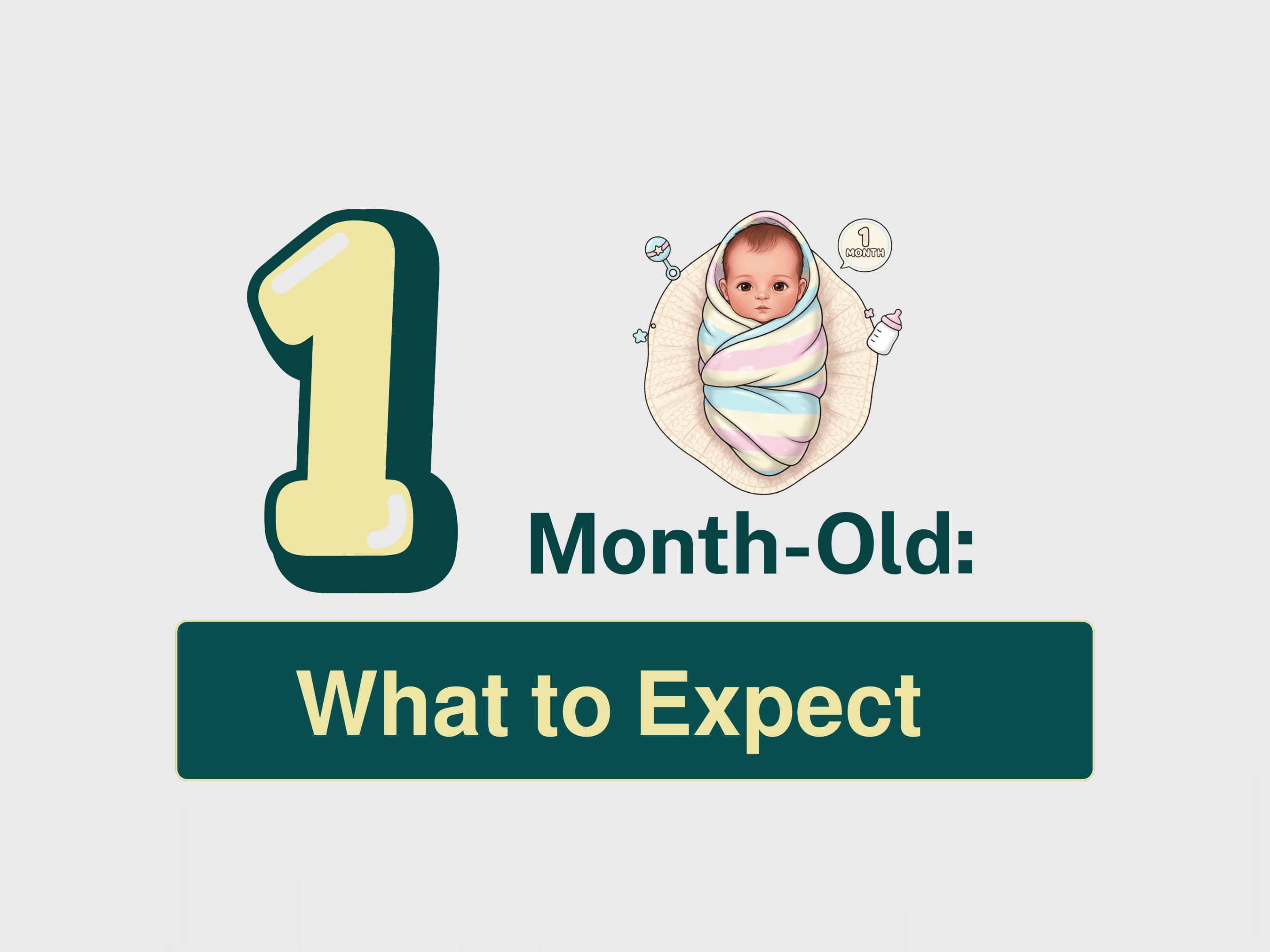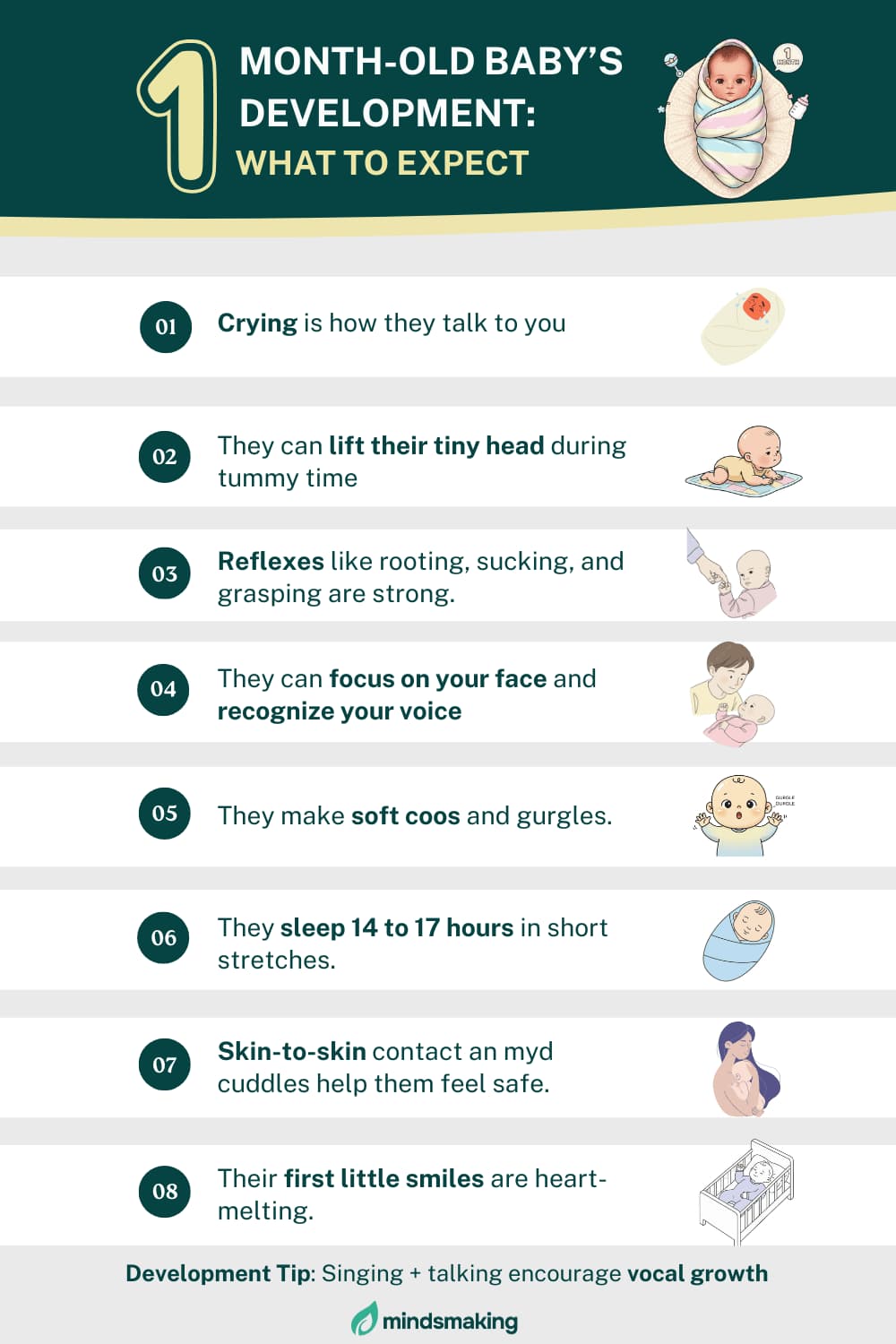Your 1-Month-Old Baby's Development

Written by Mindsmaking Medical Writer
Fact Checked by Mindsmaking Professionals
6th, October, 2025
It is easy to support your 1-month-old baby’s development when you know what to expect and when to take action. Here is what to expect and how to encourage your baby's growth at 1 month.
Physical Development
By 1 month old, your baby is gradually becoming more active, though most movements are still unplanned. You will notice involuntary baby reflexes like rooting, sucking, startling, and grasping. These are important building blocks for your baby's motor skills. In fact, your baby is developing in all areas. Here is what your 1-month-old baby's development looks like.
Key Takeaways
At 1 month, your baby still shows jerky movements, limited neck control, and normal changes like hair loss or baby acne as part of their development.
Babies at 1 month old show natural reflexes like rooting, sucking, grasping, startling, stepping, and crawling, which all support feeding, bonding, and early development.
At 1 month, babies cry to express needs, begin cooing, and use their growing senses of sight, hearing, touch, smell, and taste to connect with caregivers.
Babies at 1 month may recognize familiar voices and faces, respond to routines, and show early learning through attention, memory, and cause-and-effect awareness.
At 1 month, babies bond through eye contact, touch, and voice, show early comfort or distress, and begin responding to routines and emotional cues.
Newborns feed 8–12 times a day and sleep 14–17 hours in short stretches, with cluster feeding and frequent waking being normal parts of their routine.
The hepatitis B vaccine may be given at 1 month as a second dose or to catch up if the birth dose was missed.
Fever of 38°C (100.4°F) or higher, unusual breathing, or fewer than 4 wet diapers a day are warning signs that require a doctor’s attention.
Simple everyday interactions like talking, eye contact, tummy time, and gentle routines help your 1-month-old feel secure while building early skills for growth and bonding.
Physical Development

Neck and Head Control
Neck control is still limited at this stage, so always support your baby’s head. During tummy time, they may lift their head for a second or two before resting again. It might not look like much, but those mini push-ups are big steps toward building neck, shoulder, and back strength.

Jerky Movements
You may still notice sudden jerky movements, especially during sleep or when your baby is hungry or upset, but this is completely normal. It is just their nervous system still developing, not an attempt to act out drama.

Growth and Weight Gain
Most babies would have regained their birth weight by this time and gained an extra 1–2 pounds. Every baby grows at their own pace, so there is no need to compare. Steady progress is what matters most.

Normal Physical Changes
Some babies experience hair loss and shed hair before new strands grow in. Flat spots can appear on your baby's head from lying on their back, but usually correct themselves with time. As part of your 1-month-old baby's development, baby acne, pimples may also show up. If acne appears, gently wash your baby’s face once a day and avoid harsh detergents on bedding to avoid irritation. It is common for a baby’s hands and feet to look bluish or feel cooler than the rest of their body. This happens because their blood circulation is still adjusting. Unless it spreads or persists, it is nothing to worry about.
Reflexes
At 1 month old, your baby will show several reflexes that are part of their natural development. Reflexes are involuntary actions that newborns are born with, which help them adapt to life outside the womb. These automatic responses are not something your baby controls yet; they are just natural ways of ensuring survival and growth for your baby. The following are baby reflexes you will notice at 1 month old
Rooting Reflex: Think of this as your baby’s built-in “GPS for food.” Stroke their cheek and they’ll whip their head around like, “Yep, snack time!” This handy reflex makes breastfeeding or bottle-feeding easier, especially in those first weeks while your little one is still mastering the art of latching.
Sucking Reflex: Think of this as your baby’s built-in “vacuum mode.” Touch the roof of their mouth with a nipple (or clean finger), and they’ll start sucking right away. It’s how they feed, but also how they relax which is why you’ll catch them happily munching on fingers or a pacifier even when they’re not actually hungry.
Grasp Reflex: Imagine this to be your baby’s built-in “cling mode.” Place a finger in their palm, and they’ll grab on tight. It’s not a conscious move yet, but this reflex helps your newborn start practicing coordination while giving you the sweetest little handshake.
Startle (Moro) Reflex: A sudden sound or movement can make your baby fling out their arms, spread those tiny fingers, then pull everything back in with a cry. It may look dramatic, but this reflex is your baby’s natural alarm system. It helps them react to unexpected changes and feel secure again.
Stepping Reflex: Hold your newborn upright with their feet touching a flat surface, and they’ll make little walking motions. They’re not ready to stroll just yet, but this reflex is nature’s way of preparing the muscles and nerves for those future first steps.
Crawling Reflex: Place your baby on their tummy, and you might see them push and wriggle forward. They’re not crawling yet, but this reflex helps strengthen their muscles and builds the foundation for real crawling later in their baby development journey.
Communication and Senses
At 1 month, your baby is starting to interact with the world in more noticeable ways. Their senses sight, hearing, touch, smell, and taste are becoming more active, helping them bond with you and explore their surroundings. These growing senses also lay the foundation for early communication and connection.
Crying as Communication: At 1 month, crying is still your baby’s main way of talking to you. It signals hunger, discomfort, tiredness, or simply a need for closeness. Over time, you’ll notice patterns such as urgent cries for feeding, and a fussier whine for a diaper change.
Early Sounds: Along with crying, some babies begin experimenting with coos and gurgles when calm and alert. These sweet noises are the first steps toward language development and a sign that your baby is starting to engage with the world.
Vision: Your baby’s eyesight is still limited, but they can now focus on objects 8–12 inches away. This is perfect for gazing at your face during feeding. They may also start tracking slow movements, like a toy passing across their line of sight.
Hearing: Babies at this stage recognize familiar voices and often calm down when they hear you talk or sing softly. While self-soothing isn’t possible yet, your gentle voice or soft background sounds can comfort them.
Touch, Smell, and Taste: Skin-to-skin contact, swaddling, and cuddles make your baby feel secure. They can recognize their mother’s scent and may turn toward it instinctively during feeds. Also, babies naturally prefer sweeter flavors.
Cognitive Development
By 1 month, your baby’s brain is already learning from the world around them. They are starting to connect the dots, interpret, and make sense of their environment. These small steps lay the foundation for their future learning. Here are some signs that show your baby is undergoing brain development at 1 month old.
- Your baby may turn toward your voice or focus closely on your face, showing they’re recognizing you.
- They might follow light or track a toy with their eyes, a sign their vision is sharpening.
- They may calm down during familiar routines like rocking or feeding, which shows they’re learning patterns.
- When they cry and wait for your response, they’re beginning to understand cause and effect.
- They may react to familiar faces, places, and sounds, which means early memory is forming.
Read This Next
No posts available
Social and Emotional Development
Once your baby reaches the 1-month-old milestone, you will notice that bonding happens in the smallest ways. Eye contact, gentle touch, and your soothing voice are all important in helping your baby feel safe. For instance, when you cradle your baby and talk softly, they may calm down or become more alert. This shows that they are beginning to recognize your presence.
At this age, your baby also starts showing clear signs of comfort and distress. They may fuss when hungry, cry when overstimulated, or relax when held close to your chest. Sometimes, you will see those quick, fleeting smiles that may happen during sleep. Over time, these smiles will turn into true social smiles that respond to your face or voice. It may seem small, but those first smiles are a special way for your baby to connect with you.
Predictable routines such as feeding, sleeping, and play are also important for your baby's emotional development at this stage. This makes them feel secure at all times. For example, rocking them to sleep at the same time each night helps them feel safe enough to close their eyes. Also, babies at this age are sensitive to emotions. If you speak in a calm tone, your baby may settle more easily, while tension or stress around them can sometimes make them fussier. This shows how tuned in your 1-month-old is to emotional cues, even at this early stage.
Feeding and Sleeping
The typical newborn feeding frequency is about 8 to 12 times every 24 hours, whether breastfed or formula-fed. This means feeding every 2 to 3 hours, including night feeds. Sometimes, you may notice cluster feeding, where your baby wants to eat more often within a short time. This is normal and often happens during growth spurts. Babies hit their first growth spurt around 1 month old. You can easily tell if your baby is undergoing a growth spurt when your newborn's sleep schedule is frequent, alongside cluster feedingGood nutrition helps your baby to gain healthy weight and stay satisfied.
Sleep also takes up a big part of your baby’s day. A newborn's sleep schedule usually adds up to 14 to 17 hours in total, but in short naps of 2 to 4 hours. Waking often at night is completely normal at this stage since your baby has not developed a clear day and night rhythm. Over time, you may notice slightly longer stretches of sleep at night, but for now, short naps and frequent waking are part of their natural routine.
Safe sleep practices are very important for your 1-month-old. Always place your baby on their back to sleep, use a firm mattress, and keep the crib clear of pillows, blankets, or stuffed animals. Note that feeding and sleeping interact to foster your baby's growth and development. This is because many babies fall asleep during or right after feeding, while others wake up because they are hungry again. By gently following their feeding and sleeping cues, you will help your baby grow and develop healthily.
Vaccine
At the first month baby check-up, most babies will not receive the full set of vaccines yet. This is because many immunization schedules begin around 6 to 8 weeks. However, one important exception is the hepatitis B vaccine. If your newborn has received the first dose at birth, the second dose may be given at 1 month, depending on your doctor’s recommendation. This early protection is important in places where hepatitis B is common, as it helps guard against infection right from the start.
In some cases, if the birth dose was missed, doctors may recommend giving it at 1 month instead. Vaccination schedules can differ depending on your location, so it is advisable to confirm with your pediatrician what applies to your child. The check-up is also a good time to ask questions, review your baby’s growth, and make sure everything is on track before your baby starts taking vaccines properly.
After a vaccine, it is normal for babies to experience mild reactions such as fussiness, a slight fever, or tenderness where the injection was given. These usually pass within a day or two and are a sign that your baby’s immune system is working. As a parent, it is important to stay up to date with appointments and keep track of vaccine records. This will ensure that your child is protected against preventable illnesses.
When to See a Doctor
While many changes in your 1-month-old are normal, there are times when it is important to reach out to your doctor. If your baby has fewer than 4 wet diapers in a day, seems extremely sleepy and difficult to wake, or shows signs of persistent vomiting, these may be warning signs that something is not right. When you understand your baby’s usual patterns, it will be easy for you to quickly notice any unusual signs.
A fever is another clear signal to call your doctor. At this age, if your baby’s temperature is 38°C (100.4°F) or higher, it should never be ignored. If you also notice unusual breathing patterns such as fast breathing, long pauses, or visible effort when your baby breathes, this is a reason to seek medical help immediately.
Other concerns may include problems with feeding, signs of jaundice such as yellowing of the skin or eyes, or behaviors that do not seem typical for your baby. As a parent, it is important to trust your instincts. If something does not feel right, it is always best to check in with your healthcare provider.
How to Encourage Your 1-month-old's Development
Once your baby reaches the 1-month milestone, every small activity you do with them can help support their growth. At this stage, development is not about structured play but about everyday interactions that make your baby feel safe and connected. Unlike the newborn phase, they are becoming more alert and responsive, which allows you to engage more meaningfully. Here are simple ways to encourage your 1-month-old baby’s development
- Talk and sing often to your newborn, as this helps them get familiar with your voice and builds early listening skills.
- Make eye contact with your baby while feeding or soothing, as this helps them recognize your face and strengthens bonding.
- Place your baby on their tummy for 1 to 2 minutes, three times a day, to help them build neck, back, and shoulder strength.
- Respond to your baby’s cries or coos as this teaches them that communication brings comfort and connection.
- Keep a gentle routine for feeding, sleeping, and soothing, as this helps your baby feel secure and supported.

Was this article helpful?
How many stars are you giving this article?
Leave a comment
Your email address will not be published.